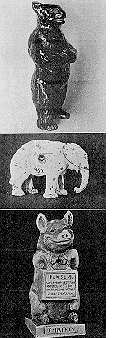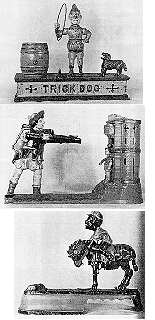AMERICAN GERMAN REVIEW, December, 1940
Pennsylvania Thrift ó Some Old-Time Penny
Banks
from the Landis Valley Museum
By Felix Reichmann
 How old are penny
banks? Naturally it is impossible to fix the actual year of their beginning, but
we may assume that they date back to the origins of coined money. The conception
of saving is probably as old as mankind itself. In their earliest experience our
primitive forefathers learned how important it was not to exhaust all their
provisions. What applies to food and fuel is also true of money, for money is
nothing else than a very useful substitute which can be exchanged at any time
for food, fuel, or such other commodities as we may wish to have.
How old are penny
banks? Naturally it is impossible to fix the actual year of their beginning, but
we may assume that they date back to the origins of coined money. The conception
of saving is probably as old as mankind itself. In their earliest experience our
primitive forefathers learned how important it was not to exhaust all their
provisions. What applies to food and fuel is also true of money, for money is
nothing else than a very useful substitute which can be exchanged at any time
for food, fuel, or such other commodities as we may wish to have.
Among the varied forms of communal life, the farming community is especially well fitted to apply the principle of saving. The early settlers in Pennsylvania, the Quakers of English stock, and the German sectarians, had a perfect understanding of the significance of thrift. Poor Richardís Almanac never ceased to extol the merits of saving. Every American schoolboy knows Benjamin Franklinís saying: "A penny saved is a penny earned." The proverbs of our Pennsylvania-Dutch country keep on repeating the advice "Schpare is zu schpot wammer mol nix me hot" (It is too late to save after everything has gone); "Was mer sich schpart des hot mer" (What one saves, one has).
In the Landis Valley Museum, near Lancaster Pennsylvania, are to be found several scores of childrenís money banks used in Pennsylvania in former times. The old Pennsylvania Germans looked at savings banks as more than mere toys; they considered them a valuable help in education. Figure 1 shows the bank which was given Henry K. Landis, one of the founders of the Museum, seventy years ago. By means of this bank and that of his brother George were formed the habits of thrift which served them so well throughout life. Henry K., or "Grossí Henner," as his friends call him, once told the author that the first five dollars so saved were immediately invested in the purchase of books. All who admire the historic collection assembled by these two men, must perforce value the habits of thrift started from such small beginnings.
"Large streams from little fountains flow,
Tall oaks from little acorns grow."
The oldest banks in the collection, dating back about 100 years (Figure 2), are made of tin, very crudely painted, mostly with red, and decorated with one of Franklinís mottoes. These banks are so constructed that it is easy to throw a piece of money into one of them, but quite difficult, owing to the absence of a lock, to get it out again. It might easily take as long as half an hour to retrieve one coin.
 More recent
devices favor replicas of a mailbox (Figure 3) or of a cash register (Figure
12), but the pick of them all (how proud must have been the boy who owned it!)
is a real small steel safe with a modern combination lock (Figure 6).
More recent
devices favor replicas of a mailbox (Figure 3) or of a cash register (Figure
12), but the pick of them all (how proud must have been the boy who owned it!)
is a real small steel safe with a modern combination lock (Figure 6).
Great public achievements or the symbols of the political parties were frequently used by the penny-bank industry to stimulate the saving spirit. T Philadelphia Centennial was the right moment to bring out a replica of the Liberty Bell (Figure 4), and the elephant, the famous symbol of the G.O.P., always found buyers in the Keystone State (Figure 8). The Tammany Hall bank (Figure 11) is a semi-mechanical one. If a penny is thrown into the slot, the man bows his head. I call it semi-mechanical, because, wonderful though it seems, it canít be compared with the marvelous performance of the banks that are really mechanical.
Take the "Trick Dog" (Figure 13), for instance. First, one puts a coin into the open mouth of the dog; then the trigger is pulled. The dog jumps through the ring and the coin drops into the savings barrel. Also William Tell is willing to devote his unfailing cross-bow to the fulfillment of instruction in saving (Figure 14). A penny or nickel is the arrow to be shot by the famous marksman. The trigger is pulled and, "bang" goes the coin right over the head of Tell, Jr., into the savings castle!
Another mechanical bank exhibits a poor Negro who vainly declares: "I always despised mules" (Figure 15). Once a coin is put into his mouth, the ill fate of the poor man is not to be stopped. The mule gets wild and starts kicking with its hind legs; the rider loses his equilibrium and falls head over heels, badly knocking his head; but the coin rolls safely into the slot.
The history of childrenís banks in this country reveals an era in the development of the American people when great emphasis was laid on saving. This was a period of unprecedented industrial growth, a time when opportunity seemed boundless, whenever new sections of the Wild West were being brought under cultivation, homesteads dotting the plains beyond the Mississippi. The Pennsylvania Germans shared in this general trend of the times and expressed their traditional thrift and conservative prosperity through penny-savings banks, which became ever more elaborate as the years passed. Ingenious mechanical devices applied to these small containers brought joy to the hearts of their young possessors, comparable only to that found in a newly invented toy. In this joyous manner were the habits of thrift subtly instilled into the minds of Pennsylvania-German youth.
 Early
Samples of Penny Banks
Early
Samples of Penny Banks
Figure 1
Globe Crowned by Eagle. Sheet iron, bronzed. When coin falls a bell rings.
Inscription: Globe Bank, Philadelphia. Given to H. K. Landis about 1870.
5-7/8" high.
Figure 2
The Oldest Bank. Tin, painted red. Inscription: Penny saved, Penny earned.
Eastern Pennsylvania, about 1850. 4-1/2" high.
Figure 3
Mail Box. Cast iron, bronzed. After 1900. 4-3/8" high.
Banks Using Typical American Motives
Figure 4.
Liberty Bell. Cast iron, wooden base. Inscription: Centennial 1876. 4-7/8"
high.
Figure 5
Home Savings Bank. Cast iron, bronzed. Inscription: Home Savings bank. About
1890. 5-7/8" high.
Figure 6
Safe. Steel. Inscription: Bank of Commerce. With combination lock. 6-1/2"
high.
 Animal
Banks
Animal
Banks
Figure 7
Bear. Cast iron. Marked: Pat. appl. for about 1880, 6-1/8" high.
Figure 8
Elephant. Cast iron. Inscription: GOP, about 1900, 4-3/4" high.
Figure 9
The Wise Pig. Cast iron. Inscription: The Wise Pig. Save a penny yesterday and
another save today, tomorrow save another to keep the wolf away ó Thrifty.
About 1900, 6-3/4" high.
Odd Banks
Figure 10.
Sailor in Boat. Sheet iron, bronzed. Inscription: Dolphin. About 1880,
4-3/8" high.
Figure 11
The Man of the Tammany Bank.
Cast iron, bronzed. When coin falls, the head of the man nods. Inscription:
Tammany Bank. Pat. 1873. 5-7/8" high.
Figure 12
Cash Register.
Tin. Inscription: Happy Days. Cash Register. Marked: J. Schein & Co. After
1910. 4-1/8" high.
 Mechanical
Savings Banks
Mechanical
Savings Banks
Samples of the way in which Pennsylvania-German parents of a few generations
ago sought to inculate the habit of saving in their children through the appeal
of mechanical toys.
Figure 13
Clown With Dog. After releasing a spring the dog jumps and the penny in his
mouth falls into the bank. Patented July 31, 1888. 8-5/8" long, 7-1/4"
high.
Figure 14
Wilhelm Tell and Son. The penny is shot into the bank above the head of Tellís
son. Patented June 23, 1896. 10-1/4" long, 6-1/2 high.
Figure 15
Negro With Mule. A coin is put into the mouth of the mule; the animal grows wild
and starts kicking with its hind legs; the rider falls off, enabling the coin to
roll into the slot. Patented April 2, 1879. 9" long, 7-7/8" high.
